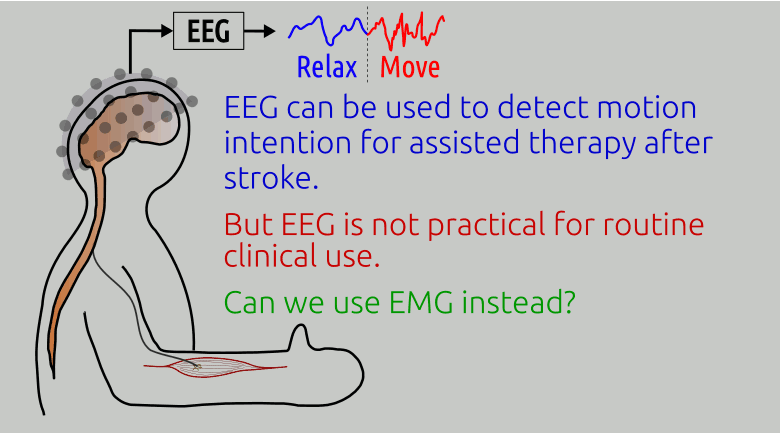Research/EMG-based INTENT DETECTION
Motivation
Active participation during training in an important factor for recovery durign therapy. Movement intent is detected from residual movements of patients to provide assisted therapy in robot-assisted and electrically-assisted therapy. However, this method does not work for severely affected patients with no residual movements. A popular method for detecting intention in this population is through the use of brain computer interface (BCI), typically using EEG BCI. Here, EEG signatures of movement intent are detected to drive assisted training.
EEG is not the most practical modality for day-to-day clinical use for assisted therapy. A recent study by Ramos et al. showed that robot-assisted therapy contingent on movement intent detected from EEG is more beneficial than assisted therapy that is not contingent on movement intent. They observed that severely affected patients with no residual movement has some residual EMG in their forearm muscles. Thus, EMG might be a more suitable alternative (or adjunct) to EEG for detecting movement intention.
Our work
We had recently carried out a secondary analysis on the data from the Ramos et al. study, and showed that a significant portion of severely affected stroke patient residual surface EMG which could be modulated volitionarlly [1].
This work appeared as a featured article in the IEEE Xplore website.
Our current efforts are on developing a robust interface for picking up surface EMG from stroke patients, and evaluate and optimize the effectiveness of EMG-triggered assisted therapy.
Reference
[1] Balasubramanian S, Garcia E, Birbaumer N, Burdet E, Ramos A. Is EMG a viable alternative to BCI for detecting movement intention in severe stroke?. IEEE Trans Biomed Eng. 2018 Mar 21. [‘*’ - Shared last authorship].
